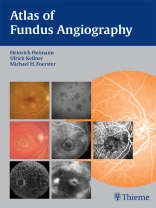Angiography of the ocular fundus is a standard examination method that should be mastered by every ophthalmologist treating posterior segment diseases.
Outstanding pictures – concise text
- Description of the most relevant disease entities seen in daily practice
- Double-page layout
- Excellent angiographic photo documentation
- Combined with significant comments on pathogenesis, indications for angiography, additional diagnostic examinations and decision making
Your advantages:
- The latest classifications of early and late AMD
- Learn standard angiographic methods
- Search for the most important angiographic patterns
- Interpret angiographies confidently
- Follow-up on recent AMD treatment regimens including intravitreal injections of VEGF-antagonists
Up-to-date application and further developments of standard techniques:
- Fluorescein angiography
- Indocyanine angiography
- Stereo-angiography
Use and limitations of evolving techniques:
- Fundus autofluorescence
- Infrared reflectance imaging
- Wide-angle imaging
Benefit from the experience of renowned lecturers in varying specialities!
Cuprins
1 Examination Methods
2 Adverse Effects of Fluorescein and Indocyanine Green Angiography
3 Age-Related Macular Degeneration and Chorioidal Neovascularization of Other Etiologies
4 Hereditary and Toxic Retinal Diseases
5 Tumors
6 Diabetic Retinopathy
7 Other Retinal Vascular Diseases
8 Diseases of the Macula and Central Retina
9 Inflammatory and Autoimmune Disorders
10 Disorders of the Optic Nerve Head












